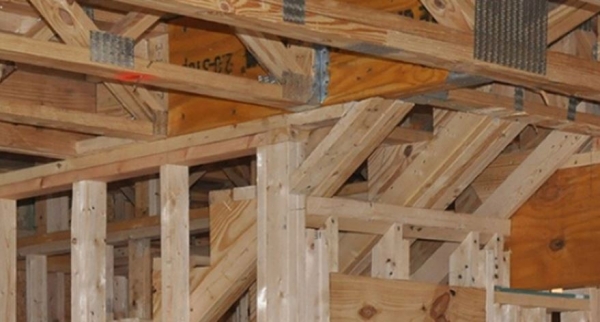Tech Update: Notches & Holes in Solid Timber Joists
How to get it right: Notches & holes in solid timber joists

When installing pipework or cabling, floor or ceiling joists may need to be notched or drilled. But this could weaken the floor to such an extent that it becomes structurally unsound.
To find out if this might be the case, guidance on notches and holes in solid timber joists for use in domestic properties can be found in section 3.22 of Eurocode 5 published by BM TRADA.
The diagrams and tables below illustrate the zones and sizes permissible for differing spans and joist depths

|
Span of timber |
Hole locations between |
Notching locations between |
||
|
mm |
0.25 of span |
0.4 of span |
0.07 of span |
0.25 of span |
|
2000 |
500 |
8800 |
140 |
500 |
|
2500 |
625 |
1000 |
175 |
625 |
|
3000 |
750 |
1200 |
210 |
750 |
|
3500 |
875 |
1400 |
245 |
875 |
|
4000 |
1000 |
1600 |
280 |
1000 |
|
4500 |
1125 |
1800 |
315 |
1125 |
|
Depth of timber |
Max hole diameter |
Max notch depth |
|
mm |
0.25 x depth mm |
0.125 x depth mm |
|
100 |
25.0 |
12.5 |
|
125 |
31.3 |
15.6 |
|
150 |
37.5 |
18.8 |
|
175 |
43.8 |
21.9 |
|
200 |
50.0 |
25.0 |
|
225 |
56.3 |
28.1 |
|
250 |
62.5 |
31.3 |
|
275 |
65 (max) |
34.4 |
|
300 |
65 (max) |
35 |
Key points for notches and holes
Before you start work check that the joist size is adequate for the span.
Notches can only be made in the top OR bottom of the joists, (not both) within the permitted area to a maximum of 35mm.
Holes may only be made on the joist's centreline within the permitted area to a maximum diameter of 65mm.
Additional holes must be at least three diameters (centre to centre) apart.
Single/multiple timber structural beams, rafters, purlins and binders must never be notched or drilled without calculations to justify the remaining timber. Rafters may be birdsmouthed by no more than 1/3rd of the depth.
This guidance does not apply to engineered joists e.g. JJI joists and reference should be made to specific product manufacturers instructions.

